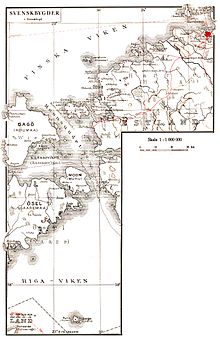| Estonian Swedish | |
|---|---|
| estlandssvenska | |
 Estonian Swedes on Ruhnu, 1937 | |
| Region | Estonia, Ukraine |
Native speakers | unknown[1] |
Indo-European
| |
| Language codes | |
| ISO 639-3 | – |
| Glottolog | esto1259 |
| IETF | sv-EE |
| Part of a series on the |
| Swedish language |
|---|
| Topics |
| Advanced topics |
| Variants |
| Dialects |
|
| Teaching |
|
Higher category: Language |
Estonian Swedish (Swedish: estlandssvenska; Estonian: rannarootsi keel, lit. 'Coastal Swedish') are the eastern varieties of the Swedish language that were spoken in the formerly Swedish-populated areas of Estonia (locally known as Aiboland) on the islands of Ormsö (Vormsi), Ösel (Saaremaa), Dagö (Hiiumaa) and Runö (Ruhnu), and the peninsula (former island) of Nuckö (Noarootsi), by the local Estonian Swedes.[2]
Until the evacuation of the Estonian Swedes near the end of World War II, both Swedish and Estonian were commonly spoken on the named islands. It is not clear if there are any native speakers left.[3] After Estonia's independence following the dissolution of the Soviet Union, Estonian Swedish experienced a revival, with courses in the language being offered on Dagö and Ösel.

Currently, the number of native speakers is unknown, but assumed to be low.[1]
- ^ a b Rosenkvist, Henrik (2018). "Estlandssvenskans språkstruktur" [The linguistic structure of Estonian Swedish] (PDF) (in Swedish). University of Gothenburg. Archived (PDF) from the original on 1 August 2020. Retrieved 18 June 2020.
- ^ "Svenska ortnamn i Estland" [Swedish place names in Estonia]. sprakinstitutet.fi (in Swedish). Institute for the Languages of Finland. Archived from the original on 9 April 2022. Retrieved 15 November 2019.
- ^ Hammarström, Harald; Forke, Robert; Haspelmath, Martin; Bank, Sebastian, eds. (2020). "Estonian Swedish". Glottolog 4.3. Archived from the original on 9 April 2022. Retrieved 2 December 2020.